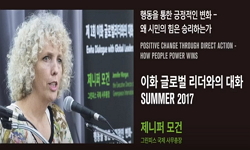The purpose of this comparative study is to examine how courts in US and Korea may take on the role of a policy facilitator that encourages policy entrepreneurs to open the policy window for addressing climate change. As the result of analyzing MA v. ...
http://chineseinput.net/에서 pinyin(병음)방식으로 중국어를 변환할 수 있습니다.
변환된 중국어를 복사하여 사용하시면 됩니다.
- 中文 을 입력하시려면 zhongwen을 입력하시고 space를누르시면됩니다.
- 北京 을 입력하시려면 beijing을 입력하시고 space를 누르시면 됩니다.
Court as a Policy Facilitator: : Comparing Republic of KOREA and US in Dealing with Climate Change CRISIS
한글로보기https://www.riss.kr/link?id=A102509838
-
저자
Kim Dong-won (Incheon National University, Incheon, Republic of Korea)
- 발행기관
- 학술지명
- 권호사항
-
발행연도
2016
-
작성언어
-
- 주제어
-
KDC
330
-
자료형태
학술저널
-
수록면
1-7(7쪽)
-
비고
학회 요청에 의해 무료로 제공
- 제공처
-
0
상세조회 -
0
다운로드
부가정보
다국어 초록 (Multilingual Abstract)
The purpose of this comparative study is to examine how courts in US and Korea may take on the role of a policy facilitator that encourages policy entrepreneurs to open the policy window for addressing climate change. As the result of analyzing MA v. EPA decided in 2007, a typical example of the judicial activism in US, it was found that the US Court widened the scope of standing to sue and ordered passive administrators and legislators to open the policy window. The US state governments and environmental advocate groups used litigation as a strategic tool to nudge the federal government to take actions in the issue area of climate change. However, climate change policy in Korea was mostly initiated and led by the president and its administration under global governance with little judicial roles. In 2006, the president promulgated the national vision on a low carbon green growth. By launching the Framework Act on Low Carbon, Green Growth in 2010, the government integrated climate change and global warming policy, new renewable energy and sustainable development pol-icy, and others, which were used to be carried out separately under the individual laws of various Ministries. The less active judicial roles are often found in the field of high specialty such as clean air affairs, the closest area to climate change. The judiciary has been deferring to administrative actions by applying the strict criteria of standing to sue and thus by limiting any chance of reviewing them by itself. The Courts, regardless of types, left an ample space for administrative discretion, and it has never been found that petition’s argument is ac-cepted against administrators’ will, whether anti-environmental or not. In particular, the Constitutional Court tends to lean toward judicial deference more than does the Supreme Court. It has rejected all cases related to clear air at the preliminary step of standing to petition even before entering into judgement on the merits. Generally speaking, it is highly difficult for civic groups and others to file a lawsuit due to their strict procedural requirements in Korea. The judiciary tends to apply the very strict criteria of standing to whether a plaintiff is qualified or not, and it seriously limits any judicial chance of reviewing administrative actions by itself. It is im-perative that related lawsuits be allowed more widely in terms of standing to sue. This will promote more active civic participation in the decision-making process of climate change policy as in US cases.
목차 (Table of Contents)
- Abstract 1. Introduction 2. US Case of Climate Change Policy 3. Korean Case of Climate Change Policy 4. Comparison Between US and Korea 5. Conclusion 6. References
- Abstract 1. Introduction 2. US Case of Climate Change Policy 3. Korean Case of Climate Change Policy 4. Comparison Between US and Korea 5. Conclusion 6. References
동일학술지(권/호) 다른 논문
-
On the Directions of Economic Education after Financial CRISIS : What to and How to Teach
- J-INSTITUTE
- Kim Tae-hwan
- 2016
-
- J-INSTITUTE
- Lee So-young
- 2016
-
Quality Characteristics of Fresh Ginseng Junkwa SAFETY from Sugar : Republic of KOREA
- J-INSTITUTE
- Song Chung-rak
- 2016
-
- J-INSTITUTE
- Lee Jae-young
- 2016




 스콜라
스콜라




